AMD Ryzen 9 5980HS Cezanne Review: Ryzen 5000 Mobile Tested
by Dr. Ian Cutress on January 26, 2021 9:00 AM EST- Posted in
- CPUs
- AMD
- Vega
- Ryzen
- Zen 3
- Renoir
- Notebook
- Ryzen 9 5980HS
- Ryzen 5000 Mobile
- Cezanne
CPU Tests: Encoding
One of the interesting elements on modern processors is encoding performance. This covers two main areas: encryption/decryption for secure data transfer, and video transcoding from one video format to another.
In the encrypt/decrypt scenario, how data is transferred and by what mechanism is pertinent to on-the-fly encryption of sensitive data - a process by which more modern devices are leaning to for software security.
Video transcoding as a tool to adjust the quality, file size and resolution of a video file has boomed in recent years, such as providing the optimum video for devices before consumption, or for game streamers who are wanting to upload the output from their video camera in real-time. As we move into live 3D video, this task will only get more strenuous, and it turns out that the performance of certain algorithms is a function of the input/output of the content.
HandBrake 1.32: Link
Video transcoding (both encode and decode) is a hot topic in performance metrics as more and more content is being created. First consideration is the standard in which the video is encoded, which can be lossless or lossy, trade performance for file-size, trade quality for file-size, or all of the above can increase encoding rates to help accelerate decoding rates. Alongside Google's favorite codecs, VP9 and AV1, there are others that are prominent: H264, the older codec, is practically everywhere and is designed to be optimized for 1080p video, and HEVC (or H.265) that is aimed to provide the same quality as H264 but at a lower file-size (or better quality for the same size). HEVC is important as 4K is streamed over the air, meaning less bits need to be transferred for the same quality content. There are other codecs coming to market designed for specific use cases all the time.
Handbrake is a favored tool for transcoding, with the later versions using copious amounts of newer APIs to take advantage of co-processors, like GPUs. It is available on Windows via an interface or can be accessed through the command-line, with the latter making our testing easier, with a redirection operator for the console output.
We take the compiled version of this 16-minute YouTube video about Russian CPUs at 1080p30 h264 and convert into three different files: (1) 480p30 ‘Discord’, (2) 720p30 ‘YouTube’, and (3) 4K60 HEVC.
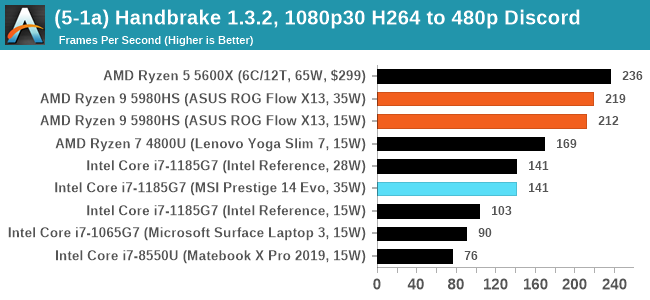
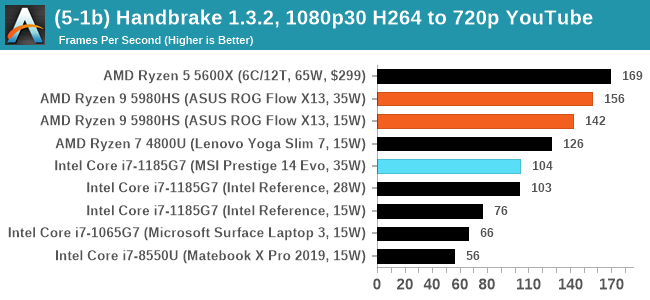
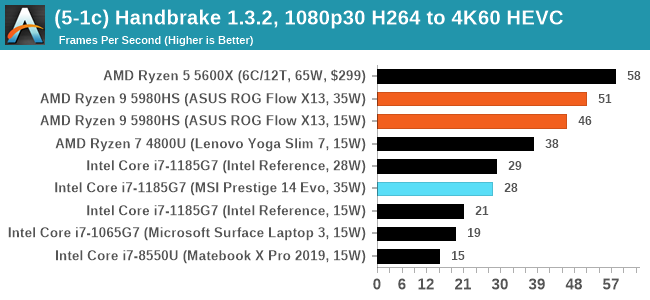
Threads wins, although the +30W difference to the desktop processor with two fewer cores can't be overhauled. Almost though.
7-Zip 1900: Link
The first compression benchmark tool we use is the open-source 7-zip, which typically offers good scaling across multiple cores. 7-zip is the compression tool most cited by readers as one they would rather see benchmarks on, and the program includes a built-in benchmark tool for both compression and decompression.
The tool can either be run from inside the software or through the command line. We take the latter route as it is easier to automate, obtain results, and put through our process. The command line flags available offer an option for repeated runs, and the output provides the average automatically through the console. We direct this output into a text file and regex the required values for compression, decompression, and a combined score.
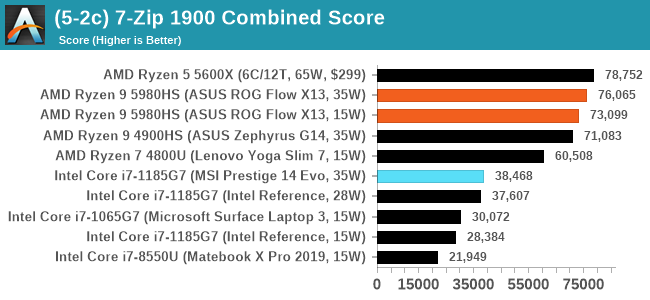
AES Encoding
Algorithms using AES coding have spread far and wide as a ubiquitous tool for encryption. Again, this is another CPU limited test, and modern CPUs have special AES pathways to accelerate their performance. We often see scaling in both frequency and cores with this benchmark. We use the latest version of TrueCrypt and run its benchmark mode over 1GB of in-DRAM data. Results shown are the GB/s average of encryption and decryption.
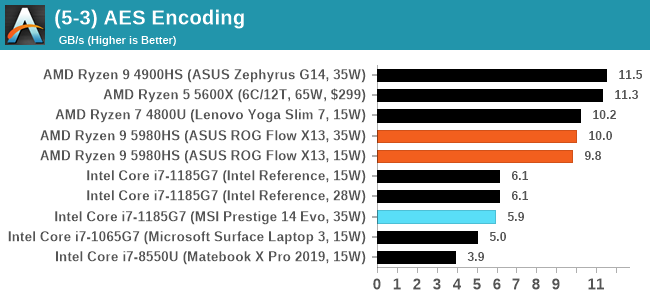
For our AES test here we actually had a small regression in performance. This could mean that there is additional performance hits to accessing the AES unit this time around, or the lower latency DDR4 of the Zephyrus is beating out the LPDDR4 on our Flow X13.
WinRAR 5.90: Link
For the 2020 test suite, we move to the latest version of WinRAR in our compression test. WinRAR in some quarters is more user friendly that 7-Zip, hence its inclusion. Rather than use a benchmark mode as we did with 7-Zip, here we take a set of files representative of a generic stack
- 33 video files , each 30 seconds, in 1.37 GB,
- 2834 smaller website files in 370 folders in 150 MB,
- 100 Beat Saber music tracks and input files, for 451 MB
This is a mixture of compressible and incompressible formats. The results shown are the time taken to encode the file. Due to DRAM caching, we run the test for 20 minutes times and take the average of the last five runs when the benchmark is in a steady state.
For automation, we use AHK’s internal timing tools from initiating the workload until the window closes signifying the end. This means the results are contained within AHK, with an average of the last 5 results being easy enough to calculate.
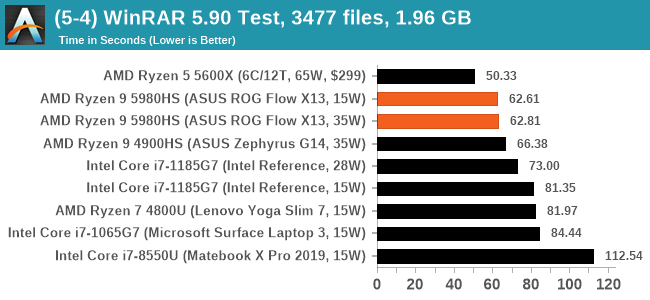
Another small performance uplift for WinRAR.


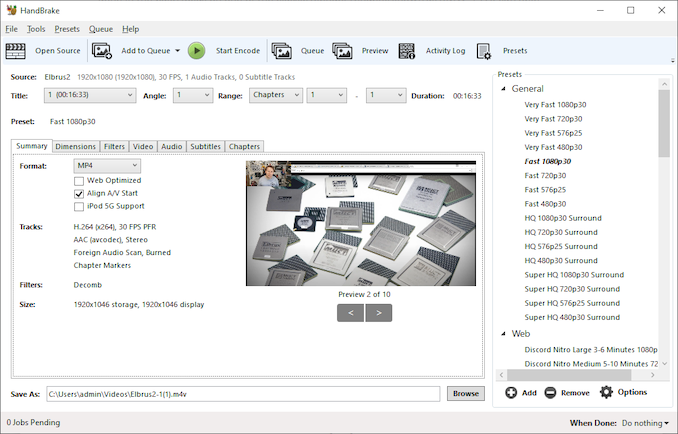
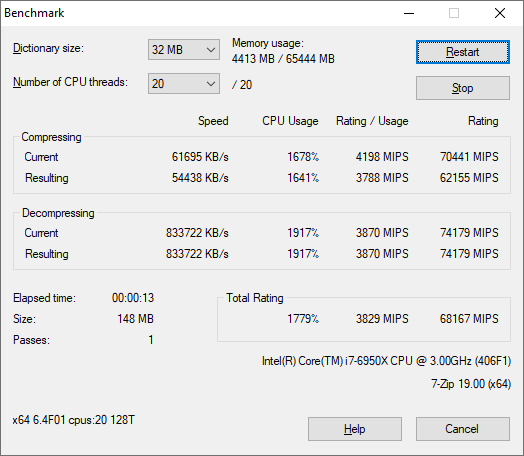
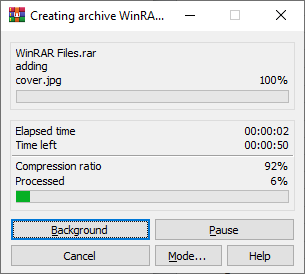








218 Comments
View All Comments
Zizy - Tuesday, January 26, 2021 - link
I wonder what is the point of new chips with old Zen2. 15% die size difference is meaningful but is that sufficient reason to bother (re)designing? As for the 5980HS, CPU part is pretty great when allowed to run at 35W. "Silent mode" is sometimes great but somewhat weird too - eg CB20MT shows a huge delta between the modes. Now lets just hope AMD/TSMC will manage to actually produce enough of these chips.ToTTenTranz - Tuesday, January 26, 2021 - link
"I wonder what is the point of new chips with old Zen2. "Diversified offer.
Fully operational Renoir is an arguably better performer than a flawed Cezanne with disabled units, and it's cheaper to make.
drothgery - Tuesday, January 26, 2021 - link
But how much cheaper? Zen 3's not that much of a bigger die than Zen 2, and it's fabbed on the same process.SaturnusDK - Wednesday, January 27, 2021 - link
How much cheaper? Until stocks last is my guess.Spunjji - Thursday, January 28, 2021 - link
I'd be interested in whether any of these differences in Lucienne are physical design alterations, as opposed to VRM / BIOS alterations, along with maybe some enabling of silicon that wasn't functional in Renoir for some reason.Either way, Lucienne's probably slightly more than 15% cheaper to make - not sure whether that would make up for the costs of extra masks and design work, though.
Farfolomew - Thursday, February 4, 2021 - link
Ian mentions in the article that he thinks AMD was stockpiling Renoir chips all of last year in order to make a big push with the 5000 series. Is it possible that the stockpiled chips are these Zen2 "Lucienne" variety and once they sell out of them, that's all there will be? I wonder if AMD is having TSMC manufacture new Lucienne chips. I mean, why would you make something that's inferior, if it's on the same exact node as a better product (Cezanne)?e36Jeff - Tuesday, January 26, 2021 - link
saving money. The Zen2 chips offer the power savings that Zen3 got with an already established design. That lets AMD sell them cheaper, and, lets face it, 95% of the end users out there would likely be blown away by a 5700U.On top of that, I would wager the Zen2 chips are a 100% straight drop in upgrade for any existing 4000 series mobile designs, possibly even with little to no BIOS update needed(beyond adding the CPU ID). That lets OEMs show off a Ryzen 5000 laptop with zero extra investment needed.
antonkochubey - Tuesday, January 26, 2021 - link
New chips with old Zen2 aren't really new chips, they're the same silicon and stepping, just running a newer firmware.jospoortvliet - Wednesday, January 27, 2021 - link
Read the review - there are lots of changes besides the cores that supposedly are also in the non-zen 3 5000 chips - given they also get the faster vega this seems true. I do agree it is weird..GeoffreyA - Wednesday, January 27, 2021 - link
From a personal point of view, I don't like this mixing of Zen 2 and 3, not at all, and certainly won't be glad of their continuing this practice; but it does make good sense. In a way, elegant.In this case, it helps to look at the cores as hidden, abstracted, a black box. Now, if such and such model fits its notch on the performance scale (5800U > 5700U > 5600U), then it shouldn't make much difference whether it's Zen 2 or 3 behind the doors. Sort of like an implementation detail.